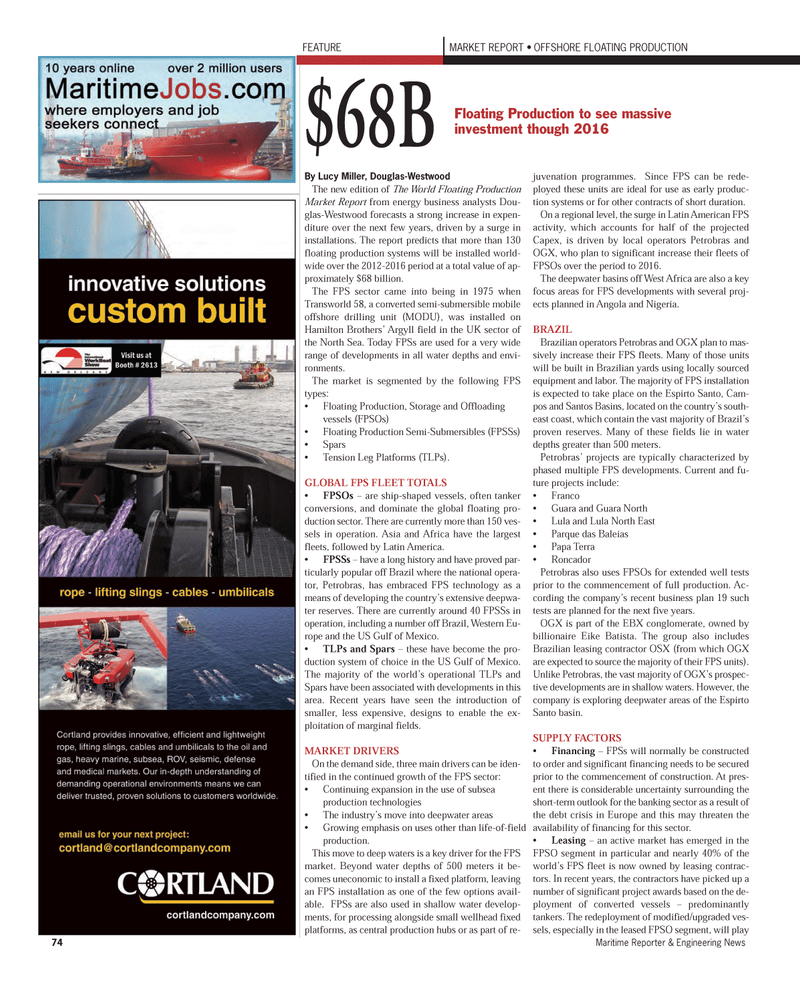
Page 74: of Maritime Reporter Magazine (November 2011)
Feature: Workboat Annual
Read this page in Pdf, Flash or Html5 edition of November 2011 Maritime Reporter Magazine
FEATURE MARKET REPORT OFFSHORE FLOATING PRODUCTION 74Maritime Reporter & Engineering News $68BFloating Production to see massive investment though 2016By Lucy Miller, Douglas-Westwood The new edition of The World Floating Production Market Report from energy business analysts Dou- glas-Westwood forecasts a strong increase in expen- diture over the next few years, driven by a surge in installations. The report predicts that more than 130 floating production systems will be installed world- wide over the 2012-2016 period at a total value of ap- proximately $68 billion. The FPS sector came into being in 1975 whenTransworld 58, a converted semi-submersible mobile offshore drilling unit (MODU), was installed on Hamilton Brothers? Argyll field in the UK sector of the North Sea. Today FPSs are used for a very wide range of developments in all water depths and envi- ronments.The market is segmented by the following FPS types:Floating Production, Storage and Offloading vessels (FPSOs) Floating Production Semi-Submersibles (FPSSs) Spars Tension Leg Platforms (TLPs). GLOBAL FPS FLEET TOTALS FPSOs? are ship-shaped vessels, often tanker conversions, and dominate the global floating pro- duction sector. There are currently more than 150 ves- sels in operation. Asia and Africa have the largest fleets, followed by Latin America. FPSSs? have a long history and have proved par- ticularly popular off Brazil where the national opera- tor, Petrobras, has embraced FPS technology as a means of developing the country?s extensive deepwa- ter reserves. There are currently around 40 FPSSs in operation, including a number off Brazil, Western Eu- rope and the US Gulf of Mexico. TLPs and Spars ? these have become the pro- duction system of choice in the US Gulf of Mexico. The majority of the world?s operational TLPs and Spars have been associated with developments in this area. Recent years have seen the introduction of smaller, less expensive, designs to enable the ex- ploitation of marginal fields. MARKET DRIVERS On the demand side, three main drivers can be iden- tified in the continued growth of the FPS sector: Continuing expansion in the use of subsea production technologiesThe industry?s move into deepwater areas Growing emphasis on uses other than life-of-field production.This move to deep waters is a key driver for the FPS market. Beyond water depths of 500 meters it be- comes uneconomic to install a fixed platform, leaving an FPS installation as one of the few options avail- able. FPSs are also used in shallow water develop- ments, for processing alongside small wellhead fixed platforms, as central production hubs or as part of re-juvenation programmes. Since FPS can be rede- ployed these units are ideal for use as early produc- tion systems or for other contracts of short duration.On a regional level, the surge in Latin American FPS activity, which accounts for half of the projected Capex, is driven by local operators Petrobras and OGX, who plan to significant increase their fleets of FPSOs over the period to 2016. The deepwater basins off West Africa are also a key focus areas for FPS developments with several proj- ects planned in Angola and Nigeria. BRAZILBrazilian operators Petrobras and OGX plan to mas-sively increase their FPS fleets. Many of those units will be built in Brazilian yards using locally sourced equipment and labor. The majority of FPS installation is expected to take place on the Espirto Santo, Cam- pos and Santos Basins, located on the country?s south- east coast, which contain the vast majority of Brazil?s proven reserves. Many of these fields lie in water depths greater than 500 meters. Petrobras? projects are typically characterized by phased multiple FPS developments. Current and fu- ture projects include: Franco Guara and Guara North Lula and Lula North East Parque das Baleias Papa Terra Roncador Petrobras also uses FPSOs for extended well tests prior to the commencement of full production. Ac- cording the company?s recent business plan 19 such tests are planned for the next five years. OGX is part of the EBX conglomerate, owned by billionaire Eike Batista. The group also includes Brazilian leasing contractor OSX (from which OGXare expected to source the majority of their FPS units). Unlike Petrobras, the vast majority of OGX?s prospec- tive developments are in shallow waters. However, the company is exploring deepwater areas of the Espirto Santo basin. SUPPLY FACTORS Financing? FPSs will normally be constructedto order and significant financing needs to be secured prior to the commencement of construction. At pres- ent there is considerable uncertainty surrounding theshort-term outlook for the banking sector as a result ofthe debt crisis in Europe and this may threaten theavailability of financing for this sector. Leasing? an active market has emerged in the FPSO segment in particular and nearly 40% of the world?s FPS fleet is now owned by leasing contrac- tors. In recent years, the contractors have picked up a number of significant project awards based on the de- ployment of converted vessels ? predominantly tankers. The redeployment of modified/upgraded ves- sels, especially in the leased FPSO segment, will play MR Nov.11 # 10 (74-81):MR Template 11/7/2011 9:16 AM Page 74

 73
73

 75
75
